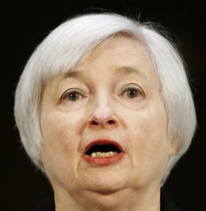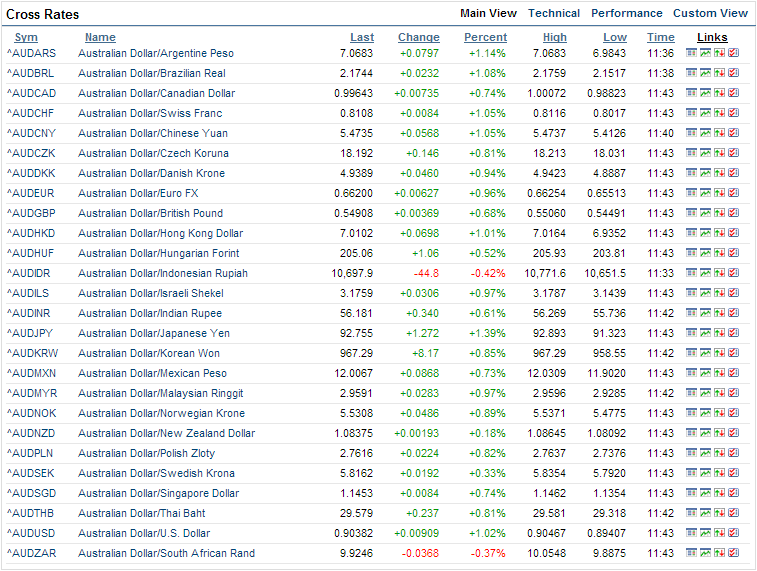
Janet Yellen appeared on Capital Hill last night and reiterated consensus:
Turning to monetary policy, let me emphasize that I expect a great deal of continuity in the FOMC’s approach to monetary policy. I served on the Committee as we formulated our current policy strategy and I strongly support that strategy, which is designed to fulfill the Federal Reserve’s statutory mandate of maximum employment and price stability.
Prior to the financial crisis, the FOMC carried out monetary policy by adjusting its target for the federal funds rate. With that rate near zero since late 2008, we have relied on two less-traditional tools–asset purchases and forward guidance–to help the economy move toward maximum employment and price stability. Both tools put downward pressure on longer-term interest rates and support asset prices. In turn, these more accommodative financial conditions support consumer spending, business investment, and housing construction, adding impetus to the recovery.
Our current program of asset purchases began in September 2012 amid signs that the recovery was weakening and progress in the labor market had slowed. The Committee said that it would continue the program until there was a substantial improvement in the outlook for the labor market in a context of price stability. In mid-2013, the Committee indicated that if progress toward its objectives continued as expected, a moderation in the monthly pace of purchases would likely become appropriate later in the year. In December, the Committee judged that the cumulative progress toward maximum employment and the improvement in the outlook for labor market conditions warranted a modest reduction in the pace of purchases, from $45 billion to $40 billion per month of longer-term Treasury securities and from $40 billion to $35 billion per month of agency mortgage-backed securities. At its January meeting, the Committee decided to make additional reductions of the same magnitude. If incoming information broadly supports the Committee’s expectation of ongoing improvement in labor market conditions and inflation moving back toward its longer-run objective, the Committee will likely reduce the pace of asset purchases in further measured steps at future meetings. That said, purchases are not on a preset course, and the Committee’s decisions about their pace will remain contingent on its outlook for the labor market and inflation as well as its assessment of the likely efficacy and costs of such purchases.
The Committee has emphasized that a highly accommodative policy will remain appropriate for a considerable time after asset purchases end. In addition, the Committee has said since December 2012 that it expects the current low target range for the federal funds rate to be appropriate at least as long as the unemployment rate remains above 6-1/2 percent, inflation is projected to be no more than a half percentage point above our 2 percent longer-run goal, and longer-term inflation expectations remain well anchored. Crossing one of these thresholds will not automatically prompt an increase in the federal funds rate, but will instead indicate only that it had become appropriate for the Committee to consider whether the broader economic outlook would justify such an increase. In December of last year and again this January, the Committee said that its current expectation–based on its assessment of a broad range of measures of labor market conditions, indicators of inflation pressures and inflation expectations, and readings on financial developments–is that it likely will be appropriate to maintain the current target range for the federal funds rate well past the time that the unemployment rate declines below 6-1/2 percent, especially if projected inflation continues to run below the 2 percent goal. I am committed to achieving both parts of our dual mandate: helping the economy return to full employment and returning inflation to 2 percent while ensuring that it does not run persistently above or below that level.
So, taper to roll then onto endless ZIRP! Stocks loved it, rising 1% and back above 1800 the S&P. Long bonds were unloved and yields pushed away from recent lows. Gold rallied another one percent as it too was suddenly convinced the Fed is loosening. The US dollar fell a few pips too. Yesterday’s whipping boy, the Australian dollar, launched to 90.5 cents and is a picture of green on the crosses, outdone only by a few recent emerging market dogs:

Our hapless RBA, which has singularly failed to deal with the age of currency wars, is undoing its good recent work at marvelous speed. Don’t get me wrong, my medium and long term view of dollar weakness is unchanged.
So, for today, taper isn’t tightening. It’s hot money risk on and yesterday’s EM crisis is today’s buying opportunity. Let’s see what happens as more taper actually transpires.

